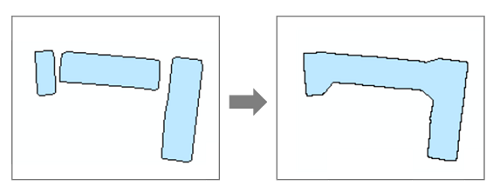Feature Description
Polygon aggregation merges polygonal features within specified distances into new polygonal features, generating aggregated polygon feature datasets.

A common application scenario involves determining the aggregation degree of rural residential areas. This typically requires indicators like contiguity ratio, which refers to merging plots or buildings within a defined range into a single patch. For example, when aggregating construction land plots with a 100-meter buffer distance, all plots within this buffer range will be merged.
Different aggregation distances produce varying effects as shown below:

Independent fragmented polygons may appear in results. These can be eliminated by setting the Minimum Area parameter:

Void areas (holes) may occur in results. These can be removed by configuring the Minimum Hole Area parameter:

Parameter Description
| Parameter | Default | Description | Type |
|---|---|---|---|
| Source Dataset | Source vector dataset | DatasetVector | |
| Target Datasource | Target datasource for storing results | Datasource | |
| Result Dataset Name | Name for output dataset | String | |
| Aggregation Distance (Optional) |
0.0 | Minimum boundary distance between polygons for aggregation. Valid values > 0. | Double |
| Unit (Optional) |
Meters | Measurement unit for aggregation distance. | Unit |
| Minimum Area (Optional) |
0.0 | Minimum area threshold for eliminating fragmented polygons. Unit corresponds with distance unit (e.g. square meters when using meters). Default 0 preserves all polygons. | Double |
| Minimum Hole Area (Optional) |
0.0 | Minimum area threshold for filling holes in aggregated polygons. Unit corresponds with distance unit. Default 0 preserves all holes. | Double |
| Aggregation Field (Optional) |
Features with identical values in this field will be aggregated. Supported types: Boolean, Integer, Long, Date, Timestamp | String |
Output
| Parameter | Description | Type |
|---|---|---|
| Result Dataset | Output vector dataset | DatasetVector |



